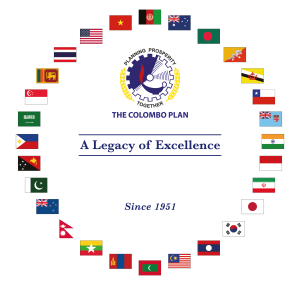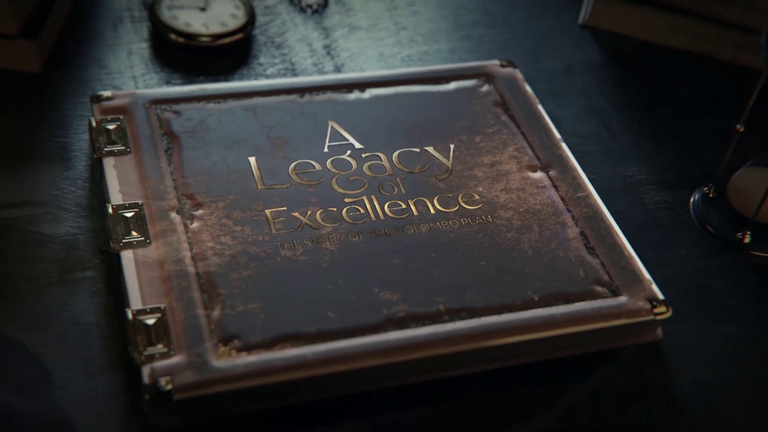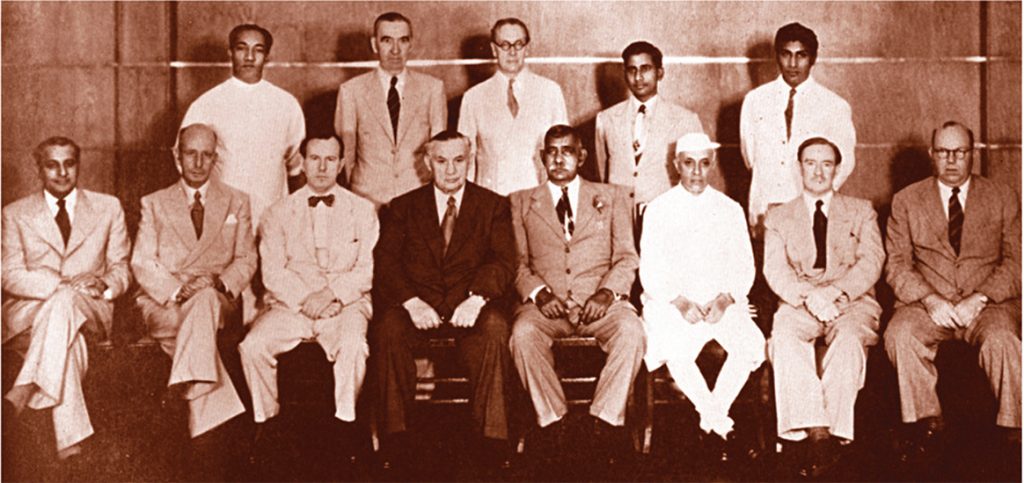The Colombo Plan for Cooperative Economic and Social Development in Asia and the Pacific is a regional inter-governmental organisation consisting of 28 member countries and operates on the partnership concept of self-help and mutual help to enhance human capital development and south-south cooperation.

Founded in 1951 by seven Commonwealth countries, namely, Australia, Canada, Sri Lanka (then Ceylon), India, New Zealand, Pakistan and the United Kingdom, The Colombo Plan endeavoured to foster and restore economic and developmental opportunities for countries in the Asia-Pacific region.
The Colombo Plan aid from developed to developing nations included both physical capital and technological transfers with a substantial component of skills development. While infrastructure such as airports, roads, railways, dams, hospitals, fertiliser plants, cement factories, universities and steel mills were built in member countries, comprehensive training programs were introduced to empower local populations with the skills needed to effectively manage these critical assets in advancing economies.
While adhering to the concept of human capital development and south-south cooperation in addressing issues of economic and social development, The Colombo Plan’s programme contents have changed over time to reflect the needs of the member countries in a rapidly changing global economic environment.
Celebrating 73 years of steadfast commitment to impactful endeavours, the Colombo Plan today, implements capacity-building programmes in over 80 countries, and stands as a testament to the power of cooperation and collective action in driving sustainable development.
Through its broad scope of programmes that include: the Drug Advisory Programme (DAP), Capacity Building Programme (CBP), Maritime Advisory Programme (MAP), Gender Affairs Programme (GAP) and the Programme for Environment and Climate Change (ECC), The Colombo Plan continues to evolve, remaining relevant and responsive to the dynamic socio-economic landscape of the region.

Celebrating 73 years of steadfast commitment to impactful endeavours, the Colombo Plan today, implements capacity-building programmes in over 80 countries, and stands as a testament to the power of cooperation and collective action in driving sustainable development.
Through its broad scope of programmes that include: the Drug Advisory Programme (DAP), Capacity Building Programme (CBP), Maritime Advisory Programme (MAP), Gender Affairs Programme (GAP) and the Programme for Environment and Climate Change (ECC), The Colombo Plan continues to evolve, remaining relevant and responsive to the dynamic socio-economic landscape of the region.

Seated
(L-R) Ghulam Mohammad (Pakistan), F.W. Doidge (New Zealand), L.B. Pearson (Canada), Ernest Bevin (United Kingdom), D.S. Senanayake (Ceylon), Jawaharlal Nehru (India), P.C. Spender (Australia), Paul Sauer (South Africa)
Standing
(L-R) J.R. Jayawardene (Ceylon), R.W. Mayhew (Canada), Philip Noel-Baker (United Kingdom), Dr. L.A. Rajapakse (Ceylon), R.G. Senanayake (Ceylon)
“The Senate Building on 9 January 1950, was shimmering white in the heat of a tropical morning when the Foreign Ministers’ Conference opened. The people of Ceylon were, however, completely unaware (as indeed were the delegates themselves) that from this conference would emerge the beginning of something which was to have an important impact on their lives…”
– Sir Percy Spender –
The Foreign Ministers of the British Commonwealth meet to discuss international affairs, in Colombo, marking the first time the heads of state representing Australia, Canada, Ceylon, India, New Zealand, Pakistan and the United Kingdom convene in an Asian country.
J.R. Jayawardene proposes joint financial assistance be provided to the region, and Sir Percy Spender presents a memorandum titled, ‘Economic Policy in South and South-East Asia’, proposing technical assistance to the region’s developing nations. Both these proposals are combined into one resolution called ‘The Colombo Plan’ and a Consultative Committee comprising of ministerial representatives and senior officials of member governments, is established to:
• Survey needs,
• Assess available and required resources, and
• Provide a framework to harness international cooperative effort and assist countries of the region to upgrade living standards.
At the first Consultative Committee Meeting, it is mutually agreed upon that the Colombo Plan should not confine itself to the Commonwealth countries, but should address development needs in South and Southeast Asia. The possibility of cooperating with non-Commonwealth countries as donors is also considered at this meeting.
Thus, invitations are extended to Burma (now Myanmar), Indonesia, the Associated States of Indo-China (Cambodia, Lao PDR and Vietnam) and Thailand. These countries alongside the initial members are asked to prepare plans for six-year development programmes. The Committee agrees to provide up to £8 million in financial aid to the region over three years beginning July 1, 1950, which put in place an initial framework from which the Colombo Plan would eventually expand.
An agreement is reached to establish a Technical Co-operation Scheme to provide a framework for the exchanged of technical assistance, co-ordinated by the Colombo Plan Council for Technical Co-operation in South and Southeast Asia. Member States are represented in this council by their respective emissaries based in Colombo, and further supported by the Colombo Plan Bureau for Technical Co-operation, located in Colombo. Representatives of the United Nations Technical Assistance Board and the United States of America also attended the meetings of the Council as liaison officers.
“The Colombo Plan was conceived in Colombo, nurtured in Australia and born in London”
-Hugh Gaitskell, Chancellor of the Exchequer, Britain –
The second Consultative Committee Meeting is held, where the six-year development plans submitted by the developing countries are examined and a report on the objectives, plans and aims of the group are drafted. The draft constitution for a Council of Technical Co-operation is reviewed and recommended to governments for adoption. It was this report that first received the iconic name, The Colombo Plan for Co-operative Economic Development in South and Southeast Asia - the Colombo Plan in shortened form. This name stems from a diplomatic resolution to a debate on what the newly formed capital aid/technical assistance programme should be called, by Robert Hunter Wade, the Head of the Eastern Political Division of the New Zealand Department of External Affairs.
At the point of inception, the United States joins as the first non-Commonwealth donor member in 1951, and continues to be one of the most active donor countries up to date. Co-operation was made available through two funding mechanisms:
1. Capital Aid – grants and loans for national development to fund projects in agriculture, power and irrigation, transportation and communication, industries, education and healthcare, and
2. Technical Co-operation – services of experts and technicians, facilities for studying abroad or within the region in advanced technology in various fields, supply of special equipment for training and research, and training facilities.
At its inception, the Colombo Plan Bureau for Technical Co-operation serves as the only permanent component of the Colombo Plan, headquartered in Colombo, and headed by a director appointed by the Council whose team comprises of an officer and a secretary. The Bureau initially undertakes the preparing of statistics relating to the technical assistance programme and later evolves to include printing of annual reports and the proceedings of the Committee meetings. Its main role continues to be that of a ‘clearing house’ serving:
• member governments - presenting achievements in national development, capital aid and technical co-operation, and
• students in member countries – making its publications available for distribution among educational institutions and libraries.
The Bureau serves as Adviser to the Consultative Committee from 1967, and attends the annual Consultative Committee Meetings in an advisory capacity from 1969. With the expansion of responsibilities by the end of the 1970s, the Bureau had a formidable team of 30 making a formidable contribution to the work of the Colombo Plan. This evolution of scope called for constitutional reform, which was effected by the Consultative Committee in 1975, with a new constitution being adopted in 1977, under which the name of the organisation was changed to, the Colombo Plan for Co-operative Economic and Social Development in Asia and the Pacific.
“From relatively small beginnings, the [Colombo] Plan has become one of history’s finest programmes in International Co-operation.”
- Hugh Gaitskell, Chancellor of the Exchequer, Britain –
The Democratic Socialist Republic of Sri Lanka has been hosting The Colombo Plan since its inception.
A memorandum of understanding signed on 20th February 1996 grants The Colombo Plan a status equivalent to that accorded to missions of international and inter-governmental organisations.
Don’t miss our future updates! Get Subscribed Today!
© 2025. The Colombo Plan Secretariat. All Rights Reserved.